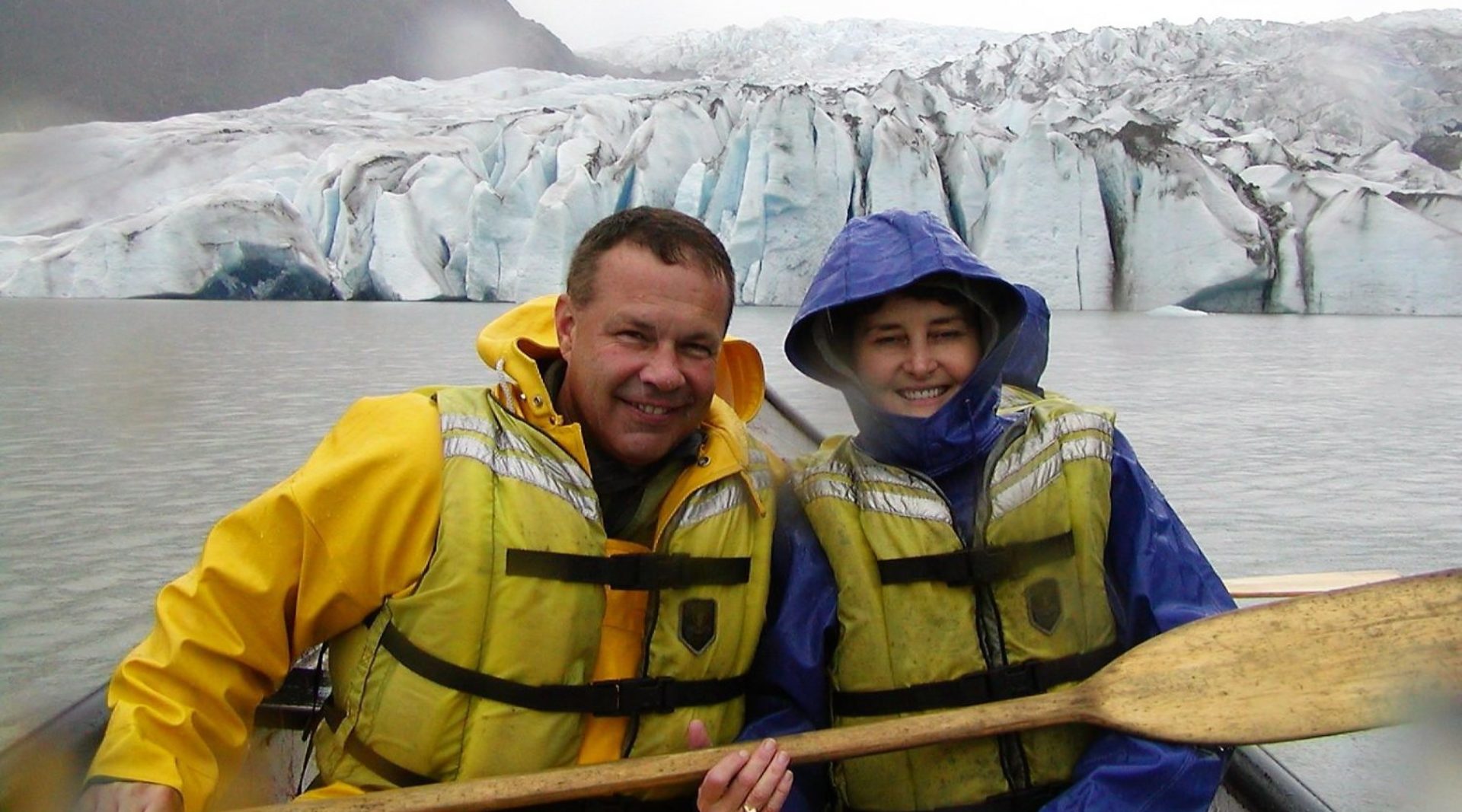Icy Interlude in Juneau Alaska
The guide sat on one end of the row boat rowing massive oars to get us as close as possible to the terminus (ending point) of Mendenhall Glacier. Eventually we were surrounded on all sides by ice, water, and mist and felt as if we were in the belly of the massive boulders of ice. In some places we could get to only 25 yards of it and in others we got out to enjoy standing on its small beaches of sediment.
Juneau Alaska provides the perfect entry point for icy exploration. It is nestled between Mount Juneau (3,576 ft.) and Mount Roberts (3,819 ft.). These mountains offer a scenic backdrop and protection from cold winds and permafrost. The weather was cool and comfortable at 60 F on that early July day as we headed out to row at Mendenhall Glacier. The skies were cloudy and there was a slight but steady drizzle. My husband and I were two of three brave adventurers in the boat with the guide and there were no others around. We suited up in rain gear at the edge of the bank. Hearing the distant roar of the water coming off the ice field caused my heart to pound in my chest and I was anxious to get moving out into the water. We sallied forth soon enough and found ourselves surrounded by ice, water, and mist in a part of Mendenhall Lake. The vertical crevices at the edge of the glacier revealed brilliant blue ice and we were humbled to silence by the roar of torrent glacial meltwater.

The area where we see the end of the glacier is the terminus and where the water is gushing is an event, a glacial-lake outburst flood, a jokulhlaup using Icelandic terminology. Looking back to the side of the lake where we entered, it was difficult to see the entry point to the area. We thought that no one else was around but then as we were standing on the beach, a kayak came out of the foggy mist into the area close enough to exchange greetings over the roar of the water. The lone person in the kayak handed us his camera and asked us to take his photograph. It was surreal to see him appear, have this brief exchange, and then see him disappear into the blue ice. I’m sure we must have looked that way when we entered and departed, a magical illusion.
Mendenhall Glacier is located in Mendenhall Valley, 12 miles from Juneau. It is approximately 13.6 miles long. It elevation id 5,184 feet. Snowfall feeds the glacial ice of Mendenhall and new ice takes 200-250 to travel from Juneau Icefield to Mendenhall Lake. The glacier and its surrounding landscape is federally protected as part of the Tongass National Forest, Juneau was founded in 1880. In the late 19th century, a Tlingit Chief named Kowee led two prospectors to a creek that emptied into the Gastineau Channel, the area now Juneau. The prospectors began panning. They found gold in a few hours and it was that discovery that set a new course for Alaska. Although Juneau is the capital, the glaciers Mendenhall, Taku, and Herbert isolate it from the rest of Alaska.

HOW WE GOT THERE
We arrived at Juneau as part of the itinerary of the Zaandam – Holland America cruise ship, a cruise of the Inside Passage of Alaska. See more about the Zaandam at https://www.hollandamerica.com. The canoe trip was an optional excursion offered by the cruise line.
See more information about the Tongass National Forest and the Mendenhall Glacier at http://www.fs.usda.gov. From there click the Mendenhall Glacier Visitor Center for information about lodging, trails, transportation, maps, and other information/activities at the Mendenhall Glacier. Also for information on Mendenhall Glacier Guide to Juneau Alaska Glaciers hiking see https://alaskatrekker.com/alaska-glaciers.
Various parts of Mendenhall pose a threat of flooding as reservoirs in the glacier fill with melting ice and eventually break through (the outburst flooding). See the most recent information at http://www.JuneauEmpire.com, posted July 13, 2018 by reporter James Brooks “Juneau scientists await unprecedented flood from Mendenhall Glacier’s Suicide Basin”.
See interactive maps, amazing photographs and tour information for all Alaska’s Parks at https://www.alaskacollection.com.
Read a recent informative and entertaining article about Alaska’s Wrangler-St. Elias National Park and how the glaciers are melting “A daring Journey Into the Big Unknown of America’s Largest National Park” by Mark Jenkins, https://www.smithsonian.com.




